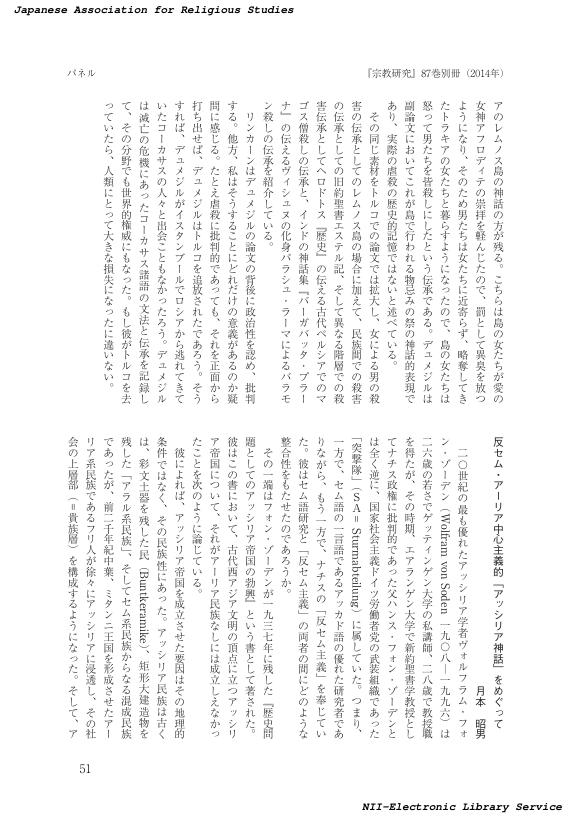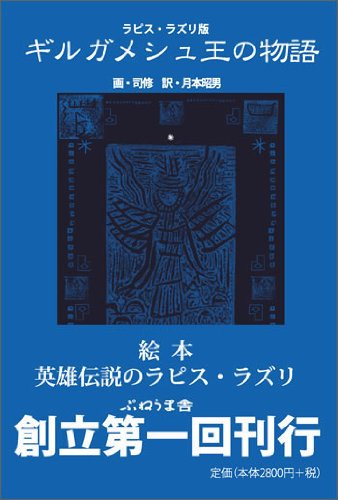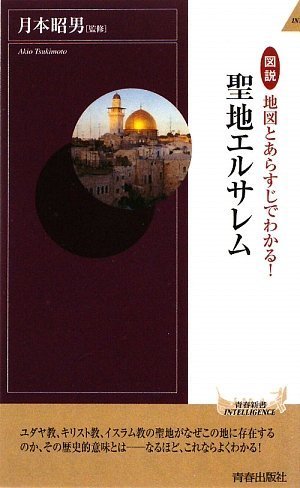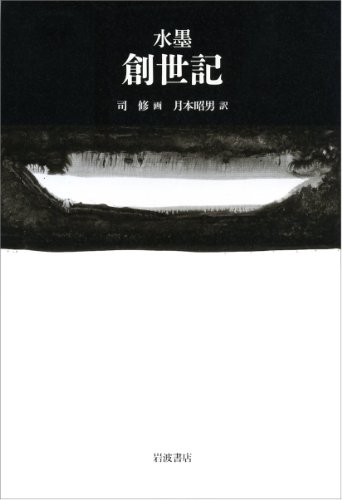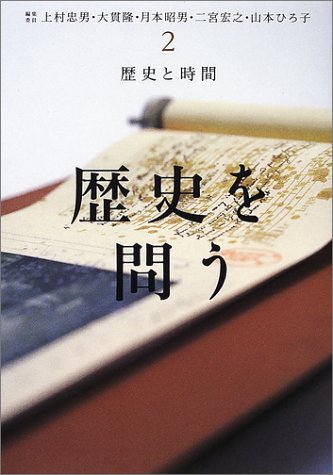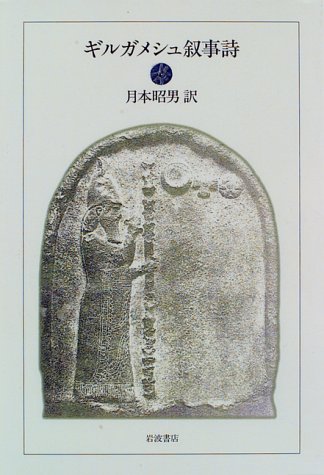- 著者
- 月本 昭男
- 出版者
- 日本宗教学会
- 雑誌
- 宗教研究 (ISSN:03873293)
- 巻号頁・発行日
- vol.87, no.Suppl, pp.51-52, 2014-03-30 (Released:2017-07-14)
6 0 0 0 OA 古代イスラエルにおける一神教の成立過程に関する考古学的研究
エン・ゲヴ遺跡(イスラエル)の発掘調査によって印章などの宗教遺物を検出し、古代イスラエルおよびそれに隣接する諸国家の成立に新ヒッタイト文化の影響が見られることを指摘した。また、この印章や「生命の木」の図像、ユダ式柱状土偶などの宗教遺物の分析を行い、それらの示す宗教的画期から、古代イスラエル王国にカナンの多神教が単純に継続されていたわけでないことを明らかにした。さらに、2011年8月には、国際カンファレンスを主催し、古代西アジアにおける多神教の代表的女神アスタルテがイスラエルとその周辺世界でどのように異なって理解されていたのかを議論した。
3 0 0 0 OA ユダヤ・イスラーム宗教共同体の起源と特性に関する文明史的研究
- 著者
- 市川 裕 佐藤 研 桑原 久男 細田 あや子 高井 啓介 月本 昭男 高橋 英海 菊地 達也 長谷川 修一 葛西 康徳 江添 誠 牧野 久実 小堀 馨子 鎌田 繁 中西 恭子 土居 由美 嶋田 英晴 志田 雅宏 櫻井 丈 小野 塚拓造 山野 貴彦 アヴィアム モルデハイ
- 出版者
- 東京大学
- 雑誌
- 基盤研究(A)
- 巻号頁・発行日
- 2013-04-01
ユダヤ教の歴史を調べていくと、のちに出現する二つの一神教、キリスト教とイスラーム、を生み出す基盤になっていることがわかる。宗教学の歴史は信仰を基盤とする西欧のキリスト教を宗教の一般モデルとしたため、このモデルから外れる諸要素は関心から外れた。しかし、イスラームとラビ・ユダヤ教はそれぞれ、シャリーアとハラハーを特徴とする啓示法の宗教であり、預言者に啓示された神の意志は、日常生活の行動様式を詳細に規定している。これら一神教の二つの異なる類型がともに古代ユダヤ社会に起源を有することを示して、一神教の歴史全体を動態的に理解する道筋を示すことは、人類の宗教史を考察する上で文明史的意義を持つものである。
- 著者
- 市川 裕 佐藤 研 桑原 久男 細田 あや子 上村 静 高井 啓介 月本 昭男 土居 由美 勝又 悦子 長谷川 修一 葛西 康徳 江添 誠 牧野 久実 高久 恭子
- 出版者
- 東京大学
- 雑誌
- 基盤研究(A)
- 巻号頁・発行日
- 2017-04-01
今年度の主たる実績は、以下の三つに分けられる。第1に、2017年8月に、イスラエルのテル・レヘシュ遺跡で、シナゴーグの全容を解明する発掘調査を実施した。これによって、本シナゴーグは、モーセ五書の巻物を置く台座と思われた石は、天井を支える支柱の礎石であることが判明し、全体は簡素な矩形の部屋に過ぎないことが明らかとなった。ここから、シナゴーグの用途を、安息日のトーラー朗読にのみ限定して考える必要がないものと想定された。第2に、出土した西暦1世紀のシナゴーグの発見がもたらす意義に関して、同時代的、宗教史的、比較宗教学的視点から、研究成果を持ち寄って、公開シンポジウムを実施した。シンポジウムの全体テーマは、「イスラエル新出土シナゴーグから 一神教の宗教史を見直す」である。( 2018年3月2日(金) 13時-18時 東京大学本郷キャンパス 法文1号館 113教室。)第3に、シナゴーグがユダヤ社会において果たした役割の変遷を、古代から中世にかけて考察するシンポジウムを実施した。シンポジウムの全体テーマは「ユダヤ共同体とその指導者たち -古代から中世へ-」である。(2018年1月21日(日)13:00-18:00 東京大学本郷キャンパス法文1号館113教室。)カイロで発見されたゲニザ文書から推定される、中世旧カイロ市(フスタート)のシナゴーグと共同体の関係について、イスラエル人の専門家の知見を得られたことは、歴史的変遷を明らかにするうえで非常に有益であった。
2 0 0 0 OA 古代メソポタミアにおける鳥卜占 (auspicium) について
- 著者
- 月本 昭男
- 出版者
- 一般社団法人 日本オリエント学会
- 雑誌
- オリエント (ISSN:00305219)
- 巻号頁・発行日
- vol.24, no.1, pp.34-48, 1981-09-30 (Released:2010-03-12)
- 被引用文献数
- 1
There are two types of divination by means of birds in Ancient Mesopotamia. The first one is auspicium, namely the practise of divining the future by the observation of the flight and behaviour of birds. We have more than 350 kinds of such omina in texts of relatively good condition.As to the relation between protases and apodoses in these omina, we can find out at least three principles which explain the reason why a positive apodosis results from a certain protasis, and a negative from another:1. principle of metaphor; an example: “if a falcon puts a raven to death the king will win over his enemy” because the falcon is compared to the king, and his enemy to the raven.2. principle of association; an example: the appearance of a black (gi6) bird wakes an association of an eclipse (an. gi6) in the future.3. principle of the dichotomy of space; an example: the existence of a falcon at the right side of a man divines a favourable future for him, while the same falcon at the left side means a malicious one.Several protases which seem extremely unlikely to happen in reality must be interpreted as the products of the imagination.The second type is concerned with the physical peculialities of sacrificial birds. There has been a discussion among scholars about “a bird” (mušen=issuru) in certain types of ominous texts. Owing to the courtesy of Mrs. G. A. Matheson, the Keeper of Manuscripts of the John Rylands Library (Manchester), we published here one more late OB text of such a type which reports the observation of “a bird”.
1 0 0 0 ギルガメシュ王の物語 : ラピス・ラズリ版
1 0 0 0 キリスト教を知りたい。 : 完全保存版
- 著者
- 月本昭男監修
- 出版者
- 学研マーケティング (発売)
- 巻号頁・発行日
- 2013
1 0 0 0 図説聖書の世界 : 聖書の壮大な物語をダイジェスト!
- 著者
- 月本昭男監修
- 出版者
- 学研マーケティング (発売)
- 巻号頁・発行日
- 2011
1 0 0 0 図説地図とあらすじでわかる!聖地エルサレム
1 0 0 0 図説旧約・新約聖書入門
1 0 0 0 図説旧約・新約聖書
- 著者
- 月本昭男監修
- 出版者
- 学研マーケティング (発売)
- 巻号頁・発行日
- 2012
1 0 0 0 歴史と時間
- 著者
- 月本昭男 [ほか] 執筆
- 出版者
- 岩波書店
- 巻号頁・発行日
- 2002
1 0 0 0 OA 講演 聖書に学ぶ : 創世記に見る人類太古の物語の現代的意義
- 著者
- 月本 昭男
- 出版者
- 藤女子大学キリスト教文化研究所
- 雑誌
- 紀要 (ISSN:13483870)
- 巻号頁・発行日
- no.16, pp.39-68, 2017-03-31
1 0 0 0 OA ハナ国とカトゥナ 中期アッシリア時代のもうひとつの「ハナ文書」
- 著者
- 月本 昭男
- 出版者
- 一般社団法人 日本オリエント学会
- 雑誌
- オリエント (ISSN:00305219)
- 巻号頁・発行日
- vol.46, no.2, pp.52-70, 2003 (Released:2010-03-12)
- 被引用文献数
- 1
In her recent book, The Land of Hana (2002), A. H, Podany classified all of the Hana-tablets published so far into three periods: the early, middle, late periods. From the late period (ca. 1400-1200 BCE), except for a dedication inscription of “Ammurapi, king of the land of Hana” (LH 16), we have just two contracts of real estate transaction (LH 15 and LH 17): one (LH 15) dealing with “an orchard in the irrigation district of the city of Qatuna, ” and the other (LH 17) with a 6 acre field in an unknown district. We can discern however that the field mentioned in the latter text must be also located in the Qatuna district because a canal adjacent to it named Hubur-GAL seems to be same as the canal attested in the former text. Now a new Hana-type tablet, written in Middle Assyrian script, can be added to the two previously known: It is also a contract concerning a 1 acre field at “the gate of Qatuna.” If it is not just coincidental that all three Hana-texts are related to the Qatuna district, Qatuna must have been the place where the scribal tradition of Hana was established in the late Hana period. This might suggest that the core land of Hana people had moved north from Terqa to Qatuna in this period. This might also explain why “the land of Hana” referred to in two of the letters of the late 13th century found at Dur-Katlimu would not be located in the Terqa district, but in a north-west Habur river region.
1 0 0 0 OA 宗教人間学の視座 : 『ギルガメシュ叙事詩』における死生観
- 著者
- 月本昭男
- 出版者
- 立教大学
- 雑誌
- 立教大学コミュニティ福祉学部紀要
- 巻号頁・発行日
- no.4, 2002-03-15
1 0 0 0 OA お別れの言葉
- 著者
- 月本 昭男
- 出版者
- 東京大学文学部宗教学研究室
- 雑誌
- 東京大学宗教学年報.別冊
- 巻号頁・発行日
- vol.27, pp.1-2, 2010-03-31
追悼文
1 0 0 0 OA パレスチナにおける都市の発達と「セム」系民族の展開
現在のイスラエル国ガリラヤ地方にあるテル・レヘシュ遺跡にて、5次にわたる考古学調査を行った。これによって、同地域における青銅器時代から鉄器時代にかけて見られる都市の発達とその文化的特性を明らかにすることができた。またアマルナ文書をはじめとする文献研究においては、上記テル・レヘシュが前2千年紀後半のエジプト碑文に言及されるアナハラトと同定されることが明らかになった。またこれまで発信地が不明であったアマルナ書簡237~239番がテル・レヘシュから発信された可能性が高いことを突き止めた。
